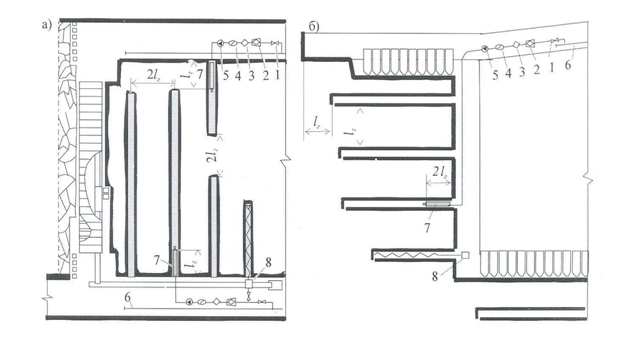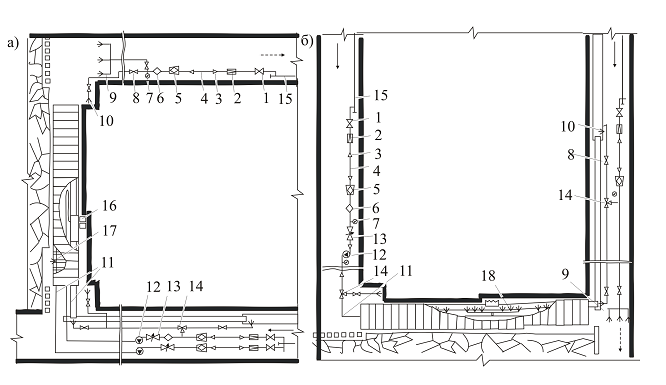Abstract
Important note: When writing this abstract the work is not yet completed. The planned completion: December 2014. January 2014. The full text of work and materials on the topic can be obtained from the author or a supervisor after defense of the thesis master's degree
Content
- 1. Actuality of theme
- 2. The aims and objectives of the work
- 3. A summary of the results of master's work
- 4. Conclusion
- References
1. Actuality of theme
Coal industry was and remains industry with the most harmful, heavy and dangerous conditions of labour.
The modern methods of coal extraction and making of the development making works by formation of plenty of dust and hit of it in the atmosphere of the mine working making I which people work.
Mine dust – the main cause of diseases of miners pneumoconiosis and bronchitis.
A fight against dust, as with professional harmfulness, predetermining possibility of workers disease of dustborne etiology, is an intricate engineering and organizational–technical problem.. The solution of this problem, i. e., reduction of dust content of air in the mine to the level of maximum permissible concentrations, is only at complex application of different ways of prevention, decline dust formation, dust neutralization and dust ladenness of mine air.
Thus fight against the explosions of a coal dust – one of the most actual problems of providing of safe terms of labour of miners in mines, developing layers dangerous on the explosions of dust.
2. The aims and objectives of the work
The aim of work is development of effective events on the decline of harmful influence of braize in the conditions of mine Russia
PA Selidovugol
Objectives: to analyze airborne dust, dust loads of miners in different processes, the actual parameters and the effectiveness of measures applied at the mine for dust control; explore the factors affecting the dust release and dust air to develop and validate a set of efficient measures to reduce particulate air pollution and prevention of diseases of miners pneumoconiosis.
3. A summary of the results of master's work
General information on the mine
PA mine Russia
SE Selidovugol
is put in operation in 1960 with design capacity of 1800 thousand tons of coal a year.
During all service life of mine its capacity repeatedly changed towards reduction. Since 2002 on mine was installed production capacity in the
volume of 700 thousand tons of coal a year.
The field of the mine Russia
is located in the South–Eastern part of the Krasnoarmeisky district of the Donetsk region of Ukraine.
The mine field is opened by two trunks – main and auxiliary. The main trunk is equipped two–skipovy by the rise providing delivery of mountain weight. The auxiliary trunk is equipped the two–cager and two–skipovy by rises. Cager rise provides performance the cargo human operations (if necessary and delivery of breed), and скиповый – delivery of breed. Rises of both trunks serve horizon 210 m.
Currently, there are two in the stope, equipped with a combine–type 1K–101 and complexes of the type 1KD–90.
Way to airing of mine – suction, scheme – the flank. Fresh air acts in mine on an auxiliary trunk (partially on the main thing) and protrudes on a surface вентиляторными installations № 2 and № 8.
Bore pit number 7 – it is used for airing developments of a southern wing of a square l21 and l1 it–is equipped by fans VOD–21 (2 pieces).
On an auxiliary trunk the is established fan installation consisting of two fans VOKD–3 which for the time being is used for cases реверсирования a ventilating current of air in mine is established.
To combat dust at the site should be used the following methods:
- coal prewetting in the solid;
- application of irrigating system on the coal cutter–loader.;
- clearing of a proceeding ventilating jet by water curtains;
- spraying of coal before the manual discharge of its niche;
- spraying on loading item;
- application of the dust removal facility delivered together with a combine;
- spraying at loading mountain weight on the conveyor or cars;
- use of personal protective equipment.
Coal prewetting in the solid
Preliminary moistening consists in the forcing of water into the massif before its destruction (it is most widespread when developing coal fields). It is carried out through the chinks drilled on a layer in parallel or perpendicularly of a plane of a clearing face, in preparatory faces, as a rule, in a plane of a face.The basic parameters, on which depends the effectiveness of this method – pressure and the rate of forcing, the distance between the bore holes, the depth of hermetic sealing bore holes, the consumption of water and time between the forcing of water and the coulisse of coal. Decrease in a dust content of air when developing the humidified massifs happens as a result of an increase in the overall humidity of the destroyed material, its easing as a result of physical and chemical and hydrodynamical processes of interoperability of water and massif and wetting of the dust, existing in the massif before its destruction [1].
Distinguish low pressure (from the water main) and high–pressure (from the pump) preliminary moistening. The use of a short–term high–pressure forcing of water into the layer is based on the assumption that the water, which penetrates under the pressure into the coal massif, increases the plasticity of coal, reduces the specific energy, accumulated by coal with the compression, displaces part of the gas and it leads to the redistribution of stresses in the critical zone. The works, carried out in this direction, make it possible to draw the conclusion that with the short–term high–pressure forcing water does not penetrate the micropores of coal, but it is moved along the large cracks, contribute to the hydraulic fracturing of a layer [1].

Fig. 1 – Flowsheets of festering of water from the preparatory making in the cleansing backwalls of declivous layers (a) and at a shield coulisse on steep layers (b)
1 – a valve; 2 – a filter a drift; 3 – a metering device of smachivatelya; 4 – a flowmeter; 5 – the pumping setting high–pressure; 6 – a drift pipeline; 7 – germetizator; 8 – a boring machine–tools
Application of irrigating system on the coal cutter–loader.
In the mechanized stope of declivous and steep layers the dust–suppression with the groove of coal is achieved with the draft on funds of irrigation, with which are equipped the excavated combines mechanized timberings, frontal and shield aggregates. On a fig. 2 flowsheets are resulted the dust–suppression the irrigation at the coulisse of declivous layers by the mechanized complex.

Fig. 2 – Flow charts irrigation dust control during excavation of shallow reservoirs mechanized complex a) and with the plow groove b)
1 – flanged valve, 2– pressure reducing valve, 3 – adapter, 4 – pressure hose, 5 – filter shtrekovy 6 – wetting agent dispenser, 7 – gauge, 8 – box–pass valve, 9 – Water Curtain, 10 – Nozzle, 11 – plumbing mud, 12 – pumping station, 13 – solenoid valve, 14 – a three–way valve box–, 15 – shtrekovy pipeline, 16 and 17 – irrigation systems combine and lining, 18 – automatic sectional irrigation.
Water curtains
The residual dust content of air on a network of mountain developments, as a rule, is at rather high level and the airflows which are starting with clearing and preparatory developments, as well as passing on a network of developments, require in additional the dust removal. For the dust removal of the air flow we use water–air (fog–forming) curtains.
For creating the water curtains of the type [VZ]–1 are used the flat – ink–jet atomizer
More effective are fog–forming the veils created fogger of type ОП–1 or ТЗ–1В. The diameter of the drops of the generatrix of fog does not exceed 10–50[mk]; therefore the atomized water long time is retained in air. For formation of a water fog in foggers tricked the water and compressed air. At the serve of the compressed air and moving of slide–valve water and compressed air enter the mixing chamber, in which is formed water–air mixture. Spraying of the latter occurs through the annular slot, with the aid of which is regulated the degree of dispersion of the water fog.
Spraying
The essence of dust–suppression by irrigation consists in the fact that with interaction of the drop of liquid with the particle of dust occurs, its moistening, seizure by drop and the precipitation of the received aggregate – dust particle – water.
Efficiency of spraying depends on the specific fluid flow rate, dispersiveness of drops, terms of capture by the by the drops of dust particle (speed of relative particle motion and drops, the electro–charge of drops), wettability of dust and uniformity of irrigation.
For the effective suppression of dust (not less than 80–90 %) at work excavated cars at optimum modes of operation of irrigators it is necessary to expend not less than 30–40 l of water by 1 t of coal, and at work of a coal cutter – 80–100 l on 1 t of culm. The decrease of the expenditure of water sharply decreases the effectiveness of irrigation at dredging and transporting [2,4].
Effective dust control, including at the same time the cleaning of dusty air and irrigation of the mountain mass of water is achieved with the use of cylindrical and conical water air ejectors. The principle of operation water air ejector (fig. 3) consists in the fact, that due to the low pressure created by water torch nozzle, hoovered dusty air, forming with dispersed water mixture, which, in turn, is sent for dust suppression.
Water air ejectors are used, in particular, for dust control when shifting sections mechanized roof supports. On the principle of ejector is also based dust control at the loading points and unloading of coal through irrigation him under the shelter with a cone nozzles.
Fig. 3 –Principle of the water–air ejector
1 – atomizer; 2 – water; 3 – dusty air; 4 – schlamm mixture
Use of personal protective equipment..
The individual defence of bodies of breath of miners from a coal and pedigree dust is carried out by means of противопылевых respirators of type F–62H which provide clearing inhaled air of a dust up to maximum permissible concentration.
Protection of bodies of breath of miners will be reliable and effective only in the event that the respirator is properly chosen on the size. Properly chosen and adjusted respirator should densely and adjoin to the person in regular intervals.
4. Conclusion
Decrease in a dust content of air in mine up to a level of maximum permissible concentration, is possible only at complex application of various ways of prevention dusting, decrease dust catching and dedusting miner air. The basic means of struggle against a dust in clearing and preparatory faces now are preliminary humidifying coal in a file, effective ventilation of air and an irrigation.
References
- НПАОП 10.0–1.01–10, Правила безопасности в угольных шахтах, Киев – 2010 [Электронный ресурс]. – Режим доступа: http://ohranatruda.in.ua/pages/4955/
- Руководство по борьбе с пылью в угольных шахтах – 1979 год.
- Александров С.Н., Булгаков Ю.Ф., Яйло В.В., Охрана труда в угольной промышленности: Учебное пособие для студентов горных специальностей высших учебных заведений. – Донецк.: ДонНТУ. 2005., 520 с.
- «Инструкция по предупреждению и локализации взрывов угольной пыли способами, основанными на применении воды» – 2003 год.
- А.О. Бабокин, Сборник инструкций и других нормативных документов по технике безопасности в угольной промышленности. Москва,
- Ищук И.Г., Поздняков Г.А. Средства комплексного обеспыливания горных предприятий: Справочник. – М. : Недра, 1991. – 253 с.
- Артамонов В.Н., Николаев Е.Б. Способ увлажнения угольного пласта. Декларационный патент на полезную модель, (13)UА,(11)9320,(51) 7 Е21F5/05 від 15.09.2005 .
